Inon D-2000 S-TTL Strobe
Introduction
At DEMA 2004 here in Houston, Mark Rupert from Inon America took a few minutes to explain the functions of their new D-2000 Strobe. This is an optically-triggered only strobe, meaning there is no place to connect an electronic sync cord. It is specifically targetted at the underwater consumer camera photographer using a Canon, Olympus, or Nikon OEM housing, and wanting automatic flash exposure control.
Inon Japan leant Wetpixel some equipment to review and test, as there is a lot of interest in the D-2000 and many questions about how well it works.
Equipment Tested
We received:
D-2000 Strobe
Grip Base DIII w/ Rubber Grip D
Direct Arm Z Set
Olympus C5060WZ
Olympus PT-020
D Base PT-020
Optical D Cable/Cap W9 Set
-.5 Stop White Diffuser for D-2000
-.5 Stop Blue Diffuser for D-2000
Red Film for Strobe Mod Light
![]()
Front: Olympus C-5060, Olympus PT-020, Inon D-2000, Optical D-Cable w/ cap and clamp, D Base PT-020, Direct Arm Z Set
![]()
Rear: Olympus C-5060, Olympus PT-020, Inon D-2000, Optical D-Cable w/ cap and clamp, D Base PT-020, Direct Arm Z Set
Test Methodology
I tried to approach the equipment for this review as any normal photographer that had just purchased new equipment from a dealer. I opened everything, put it together, read the instructions (not necessarily in that order), set all of the controls, and started taking pictures. I confess that I made no attempt to understand how Inon's S-TTL works, I just wanted to confirm THAT it works. Since I just tested the Ikelite Canon eTTL2 functionality last weekend, I decided to use the same test methodology (except this time not in the swimming pool). I shot a number of exposures, each one f-stop different, and left the strobe to decide what power to use.
![]()
The test setup showing that the subject is set up about one foot from the camera and strobe to subject distance is about one foot.
![]()
The Olympus C-5060 with the Inon Clear Photo Film covering the camera's flash. The Clear Photo Film only allows IR light to pass through to trigger the strobe, and blocks visible light from influencing the exposure.
Manual Power Control Testing
First, I developed a "control" set of photos by using the strobe with manual power control. I set up the camera and strobe-to-subject distance at one foot. I used the Inon Clear Photo Film to cover the internal flash on the Olympus, so the only visible light in the photos comes from the D-2000. I set the flash to F2.8 and the camera to F2.8 and took a photo. Next I set the strobe to F8 and the camera to F8 and took a photo. They both should show the same exposure, and they do, as shown in the table below.
F2.8 1/125th Manual Strobe Power Setting @ F2.8 | |
F8 1/125th Maunal Strobe Power Setting @ F8 |
S-TTL Testing
Now that I'd confirmed that the strobe was functional, I set it up for S-TTL automatic control. I set the power dial to TTL, the main control to S-TTL Low as directed by the instructions as a starting point, and set the mod. light to half press (instead of always on).
![]()
The back of the Inon D2000 showing the settings used for this test: Strobe set to S-TTL Low, Power set to TTL, Mod Light set to half press
I took a set of four photos, starting at F2.8, and ending at F8, with a full stop difference between each. A full stop difference means that the strobe will have to double its output each time in order to expose the same shot. The results are presented below, along with histograms for each picture. You can see that I used a dark background (the left part of the histogram), a brown detailed subject (in this case, a statue of the Indonesian god Garuda), and a white piece of paper under the subject. I think that this mix of blue, white, and detailed brown is a good representation of an underwater scene. There was dim light in the room, so all of the light in each photo was provided by the strobe. This is typical of a macro composition, or a mid-sized fish or other reef critter.
F2.8 1/125th S-TTL Low | |
F4 1/125th S-TTL Low | |
F5.6 1/125th S-TTL Low | |
F8 1/125th S-TTL Low |
Based on the test photos, it looks like the S-TTL is working well. Without any quantative analysis, I'd say that each shot is within 1/2 stop difference in exposure value. Surprisingly, based on the histograms, it looks like the higher F-stop shots got a little more strobe light, as the peak for the white on the right moves over as the F-stop goes up. Fortunately, the histogram never ended up hitting the right, indicating that the shot is not being overexposed.
Reflective Subjects
To simulate blue water with a reflective subject, I used a regulator on my crushed velvet backdrop. Again, the strobe is set at S-TTL Low and the strobe to subject distance is roughly one foot. The results are presented below:
![]()
A reflective subject shot at f3.2 1/125th in S-TTL Low
![]()
A reflective subject shot at f8 1/125th in S-TTL Low
I'm not sure exactly what happened, but the strobe is certainly not throwing as much flash into the second picture. I reset the strobe from S-TTL Low to S-TTL as recommend by the instruction manual, and tried again:
![]()
A reflective subject shot at f3.2 1/125th in S-TTL
![]()
A reflective subject shot at f8 1/125th in S-TTL
Normal S-TTL seems to work a bit better, but the two exposures are still more than a stop different.
Canon "Point and Shoot" S-TTL Test
I also tried the D-2000 with my Canon S400 and WPDC800 housing. The camera is a fully automatic "point and shoot" so it almost always selects f2.8 when used underwater.
![]()
The Inon Bayonet Mount base and cable holder rigged up with the D-2000
I used the same setup for the strobe, 1/2 stop opaque diffuser, strobe set to S-TTL Low, and camera set to ISO100. Talking with Mark Rupert at DEMA 2004, he mentioned that the JPEG engine in Canon cameras tends to result in a warm or "pinkish" exposure. Sure enough, I got a good exposure with the D-2000, but the auto white balance ended up way too warm.
![]()
F2.8 @ 1/60th - Opaque diffuser and strobe set to S-TTL Low
To accomodate the Canon JPEG engine, Inon has released a diffuser that is tinted slightly blue/green. I switched out the diffusers with the 1/2 stop - blue and repeated the test. The results were much closer to what I was hoping for.
![]()
F2.8 @ 1/60th - Blue diffuser and strobe set to S-TTL Low
Conclusion
The D-2000 works as advertised as an automatic exposure control strobe for use with consumer cameras. When set up for S-TTL, it reliably yields the same exposure regardless of f-stop. It is versatile, and if the user feels that automatic control may not result in the best photo, a full selection of manual power settings is available. The strobe also allows for flash compensation, if you find the unit is consistently under or overexposing with your camera setup. I would recommend this strobe to friends who are just entering the digital underwater photography hobby and plan on using one of the inexpensive OEM housings. The INON tray, handle, optical cord and strobe all work very well together as a system.
3-15-05 Update:
I've had a chance to try out the D2000 in the pool and I also used it on a few dives at Stetson Bank. Here are a few samples - the only image adjustment performed was cropping and resizing for the web. Exposure has not been altered at all from what came out of the camera. As recommended by Inon, I set the strobe to S-TTL "B"
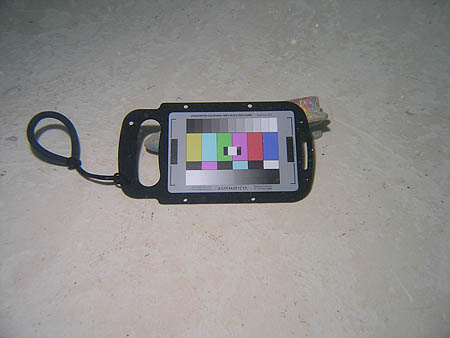
A photo from the pool test f2.8 @ 1/125th
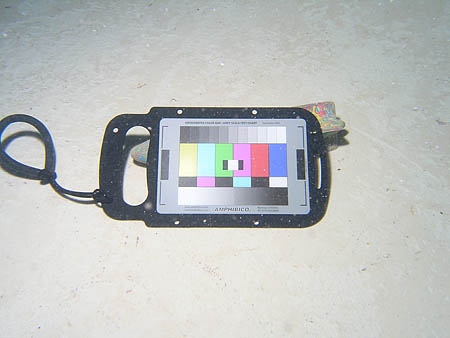
Another photo from the pool test f8 @ 1/125th (not cropped, I was aparently a little closer)

An underwater photo taken at f4.5 @ 1/100th
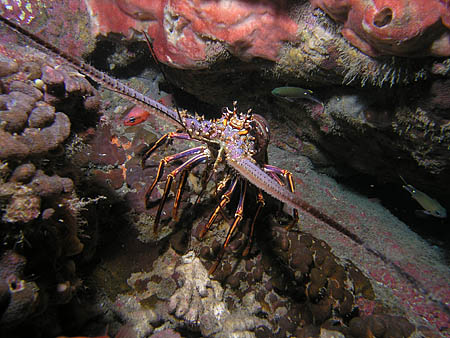
f6.3 @ 1/100th
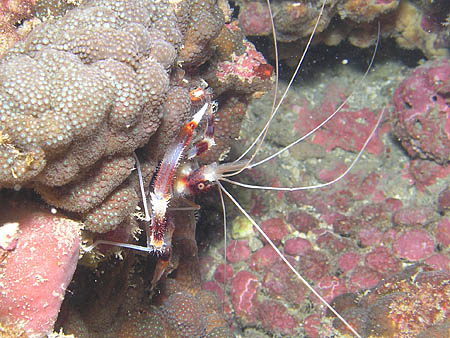
f6.3 @ 1/100th. Camera set to macro mode
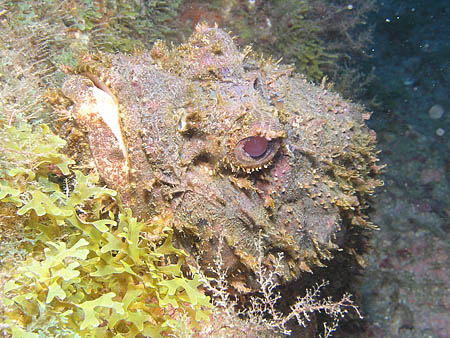
f8 @ 1/100th Camera set to macro mode
2-22 Update - I received an email from Inon Japan explaining the proper settings for S-TTL with the Olympus 5060. I just assumed it should be set to TTL, but you know what they say about making assumptions... Apparently my TTL test still worked out, because I was shooting above water, and I had the strobe set to S-TTL Low, and it should have been set to S-TTL: